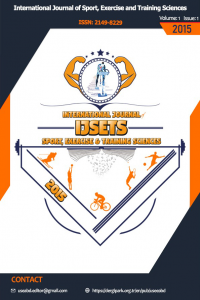Balance board vs balance ball: which one is superior in enhancing static and dynamic balance abilities on healthy university students
Balance board vs balance ball: which one is superior in enhancing static and dynamic balance abilities on healthy university students
Aim: The purpose of this study was to compare the effects of two different unstable surfaces balance training on static and dynamic balance abilities.
Keywords:
Balance training, Bosu Perimeter length, Unstable surface,
___
- Aksit, T. & Cırık, G. (2017). Comparison of static and dynamic balance parameters and some performance characteristics in rock climbers of different levels. Turkish Journal of Sport and Exercise, 19(1), 11-17.
- Amico, A.P., Nisi, M., Covelli, I., Polito, A.M., Damiani, S., Ianieri, G., Megna, M., & Fiore, P. (2014). Efficacy of Proprioceptive Training with Prokin System in Balance Disorders from Multiple Sclerosis. Multiple Sclerosis Journal, 1, 110.
- Atilgan Erkut, O. (2013). Effects of trampoline training on jump, leg strength, static and dynamic balance of boys. Science of Gymnastics Journal, 5(2), 15-25.
- Balogun, J.A., Adesinasi, C.O., & Marzouk, D.K. (1992). The effects of a wobble board exercise training program on static balance performance and strength of lower extremity muscles. Physiotherapy Canada, 44(4), 23-30.
- Braun Ferreira, L.A., Pereira, W.M., Rossi, L.P., Kerpers, I.I., Rodrigues de Paula, A. Jr, & Oliveira, C.S. (2011) Analysis of electromyographic activity of ankle muscles on stable and unstable surfaces with eyes open and closed. Journal of Bodywork and Movement Therapies, 15(4), 496-501.
- Calatayud, J., Borreani, S., Martin, J., Martin, F., Flandez, J., & Colado, J.C. (2015). Core muscle activity in a series of balance exercises with different stability conditions. Gait & Posture, 42(2), 186-192.
- Cerrah, A.O., Bayram, I., Yıldızer, G., Uğurlu, O., Şimşek, D., & Ertan, H. (2016). Effects of functional balance training on static and dynamic balance performance of adolescent soccer players. International Journal of Sports, Exercise and Training Science, 2(2), 73-81.
- Cug, M., Duncan, A., & Wikstrom, E. (2016). Comparative effects of different balance-training–progression styles on postural control and ankle. Force production: a randomized controlled trial. Journal of Athletic Training, 51(2), 101-110.
- Di Stefano, L.J., Clark, M.A., & Padua, D.A. (2009). Evidence supporting balance training in healthy individuals: a systemic review. Journal of Strength Conditioning Research, 23(9), 2718-2731.
- Emery, C.A., Cassidy, J.D., Klassen, T.P., Rosychuk, R.J., & Rowe, B.H. (2005). Effectiveness of a home-based balance-training program in reducing sports-related injuries among healthy adolescents: a cluster randomized controlled trial. CMAJ, 172(6), 749-754.
- Eosin, T.C., Danoff, J.V., Leone, J.E., & Miller, T.A. (2010). The effects of multiaxial and uniaxial unstable surface balance training in college athletes. Journal of Strength Conditioning Research, 24(7), 1740-1745.
- Granacher, U., Gollhofer, A., & Kriemler, S. (2010). Effects of balance training on postural sway, leg extensor strength, and jumping height in adolescents. Research Quarterly for Exercise and Sport, 81(3), 245-251.
- Gribble, P.A. & Hertel, J. (2004). Effect of hip and ankle muscle fatigue on unipedal postural control. Journal of Electromyographic Kinesiology, 14(6), 641-646.
- Hrysomallis, C. (2011). Balance ability and athletic performance. Sports Medicine, 41(3), 221-232.
- Kibele, A., Granacher, U., Muehlbauer, T., & Behm, D.G. (2015). Stable, unstable, and metastable states of equilibrium: definitions and applications to human movement. Journal of Sports Science and Medicine, 14(4), 885-887.
- Kidgell, D.J., Horvath, D.M., Jackson, B.M., & Seymour, P.J. (2007). Effect of six weeks of dura disc and mini-trampoline balance training on postural sway in athletes with functional ankle instability. Journal of Strength Conditioning Research, 21(2), 466-469.
- Kilroy, E.A., Crabtree, O.M., Crosby, B., Parker, A., & Barfield, W.R. (2016). The effect of single-leg stance on dancer and control group static balance. International Journal of Exercise Science, 9(2), 110-20.
- Lohman, T.G., Roche, A.F., & Martorell, R. (1991). Anthropometric standardization reference manual. Champaign, USA: Human Kinetics.
- Lubetzky-Vilnai, A., McCoy, S.W., Price, R., & Ciol, M.A. (2015). Young adults largely depend on vision for postural control when standing on a bosu ball but not on foam. Journal of Strength Conditioning Research, 29(10), 2907-2918.
- Ogaya, S., Ikezoe, T., Soda, N., & Ichihashi, N. (2011). Effects of balance training using wobble boards in the elderly. Journal of Strength Conditioning Research, 25(9), 2616-2622.
- Paillard, T. & Noé, F. (2015). Techniques and methods for testing the postural function in healthy and pathological subjects. BioMed Research International, 891390.
- Samuel, A.J., Solomon, J., & Mohan, D. (2015). A critical review on the normal postural control. Physiotherapy and Occupational Therapy Journal, 8(2), 71-75.
- Silva, P.B., Mrachacz-Kersting, N., Oliveira, A.S., & Kersting, U.G. (2018). Effect of wobble board training on movement strategies to maintain equilibrium on unstable surfaces. Human Movement Science, 58(1), 231-238.
- Taube, W., Gruber, M., & Gollhofer, A. (2008). Spinal and supraspinal adaptations associated with balance training and their functional relevance. Acta Physiologica (Oxf), 193(2), 101-116.
- Yaggie, J.A. & Champbell, B.M. (2006). Effects of balance training on selected skills. Journal of Strength Conditioning Research, 20(2), 422-428.
- Zech, A., Hübscher, M., Vogt, L., Banzer, W., Hänsel, F., & Pfeifer, K. (2010). Balance training for neuromuscular control and performance enhancement: a systematic review, Journal of Athletic Training, 45(4), 392-403.
- ISSN: 2149-8229
- Başlangıç: 2015
- Yayıncı: İbrahim ERDEMİR
Sayıdaki Diğer Makaleler
Gülbin RUDARLI NALÇAKAN, Yeliz YOL
